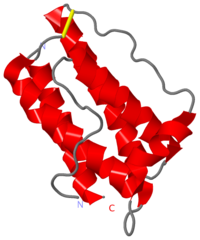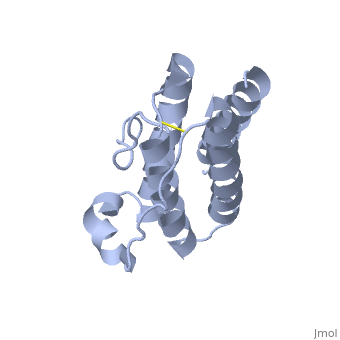User:Mary Ball/Leptin
From Proteopedia
m (User.Mary Ball/Leptin moved to User:Mary Ball/Leptin) |
|||
| Line 1: | Line 1: | ||
| - | + | {{Seed}} | |
| + | [[Image:1ax8.png|left|200px]] | ||
| + | |||
| + | <!-- | ||
| + | The line below this paragraph, containing "STRUCTURE_1ax8", creates the "Structure Box" on the page. | ||
| + | You may change the PDB parameter (which sets the PDB file loaded into the applet) | ||
| + | or the SCENE parameter (which sets the initial scene displayed when the page is loaded), | ||
| + | or leave the SCENE parameter empty for the default display. | ||
| + | --> | ||
| + | {{STRUCTURE_1ax8| PDB=1ax8 | SCENE= }} | ||
| + | |||
| + | ===HUMAN OBESITY PROTEIN, LEPTIN=== | ||
Mutations in the obese gene (OB) or in the gene encoding the OB receptor(OB-R) result in obesity, infertility and diabetes in a variety of mouse phenotypes. The demonstration that OB protein (also known as leptin) can normalize body weight in ob/ob mice has generated enormous interest. Most human obesity does not appear to result from a mutant form of leptin: rather, serum leptin concentrations are increased and there is an apparent inability to transport it to the central nervous system (CNS). Injection of leptin into the CNS of overfed rodents resistant to peripheral administration was found to induce biological activity. Consequently, for the leptin to act as a weight-lowering hormone in human obesity, it appears that appropriate concentrations must be present in the CNS. This places a premium on understanding the structure of the hormone in order to design more potent and selective agonists. | Mutations in the obese gene (OB) or in the gene encoding the OB receptor(OB-R) result in obesity, infertility and diabetes in a variety of mouse phenotypes. The demonstration that OB protein (also known as leptin) can normalize body weight in ob/ob mice has generated enormous interest. Most human obesity does not appear to result from a mutant form of leptin: rather, serum leptin concentrations are increased and there is an apparent inability to transport it to the central nervous system (CNS). Injection of leptin into the CNS of overfed rodents resistant to peripheral administration was found to induce biological activity. Consequently, for the leptin to act as a weight-lowering hormone in human obesity, it appears that appropriate concentrations must be present in the CNS. This places a premium on understanding the structure of the hormone in order to design more potent and selective agonists. | ||
| + | |||
| + | |||
| + | Quiz: | ||
<quiz display=simple> | <quiz display=simple> | ||
| - | { | + | {Most human obesity is the result of mutant forms of leptin. |
|type="()"} | |type="()"} | ||
| - | + | - true | |
| - | + | + false | |
| - | || | + | || Most obese humans actually have increased concentrations of normal leptin. So maybe cells in the brains of many obese people are just unresponsive to leptin. |
| - | { | + | {Leptin is a type of: |
|type="()"} | |type="()"} | ||
| - | - | + | - Gene |
| - | + | + | + Protein |
| - | - | + | - RNA |
| - | - | + | - Carbohydrate |
| - | || | + | ||The mouse gene named obese was found to code for a protein, which was named leptin. |
| - | + | ||
{ | { | ||
|type="{}"} | |type="{}"} | ||
| - | + | What gene symbol was assigned to the obese gene? | |
| - | { | + | { OB } |
| - | { | + | {What is the biological function of leptin? |
| - | |type=" | + | |type="()"} |
| - | + | - It is an enzyme. | |
| - | - | + | - It is a membrane receptor. |
| - | + | + | + It is a hormone. |
| - | - | + | - It is an intracellular hormone receptor. |
| - | + | { Which of these structures represents Leptin? | |
| - | { Which of these structures | + | |type="()"} |
| - | + | ||
- [[Image:1stp.png|100px]] | - [[Image:1stp.png|100px]] | ||
| - | + [[Image:1acj.png|100px]] | + | + [[Image:1ax8.png|100px]] |
| - | + | - [[Image:1acj.png|100px]] | |
| + | - [[Image:1zgc.png|100px]] | ||
</quiz> | </quiz> | ||
| - | |||
| - | |||
| - | {{Seed}} | ||
| - | [[Image:1ax8.png|left|200px]] | ||
| - | |||
| - | <!-- | ||
| - | The line below this paragraph, containing "STRUCTURE_1ax8", creates the "Structure Box" on the page. | ||
| - | You may change the PDB parameter (which sets the PDB file loaded into the applet) | ||
| - | or the SCENE parameter (which sets the initial scene displayed when the page is loaded), | ||
| - | or leave the SCENE parameter empty for the default display. | ||
| - | --> | ||
| - | {{STRUCTURE_1ax8| PDB=1ax8 | SCENE= }} | ||
| - | |||
| - | ===HUMAN OBESITY PROTEIN, LEPTIN=== | ||
Revision as of 10:44, 8 June 2010
| |||||||||
| 1ax8, resolution 2.40Å () | |||||||||
|---|---|---|---|---|---|---|---|---|---|
| Gene: | OBESE GENE (Homo sapiens) | ||||||||
| |||||||||
| |||||||||
| Resources: | FirstGlance, OCA, RCSB, PDBsum | ||||||||
| Coordinates: | save as pdb, mmCIF, xml | ||||||||
HUMAN OBESITY PROTEIN, LEPTIN
Mutations in the obese gene (OB) or in the gene encoding the OB receptor(OB-R) result in obesity, infertility and diabetes in a variety of mouse phenotypes. The demonstration that OB protein (also known as leptin) can normalize body weight in ob/ob mice has generated enormous interest. Most human obesity does not appear to result from a mutant form of leptin: rather, serum leptin concentrations are increased and there is an apparent inability to transport it to the central nervous system (CNS). Injection of leptin into the CNS of overfed rodents resistant to peripheral administration was found to induce biological activity. Consequently, for the leptin to act as a weight-lowering hormone in human obesity, it appears that appropriate concentrations must be present in the CNS. This places a premium on understanding the structure of the hormone in order to design more potent and selective agonists.
Quiz:
Mutations in the obese gene (OB) or in the gene encoding the OB receptor(OB-R) result in obesity, infertility and diabetes in a variety of mouse phenotypes. The demonstration that OB protein (also known as leptin) can normalize body weight in ob/ob mice has generated enormous interest. Most human obesity does not appear to result from a mutant form of leptin: rather, serum leptin concentrations are increased and there is an apparent inability to transport it to the central nervous system (CNS). Injection of leptin into the CNS of overfed rodents resistant to peripheral administration was found to induce biological activity. Consequently, for the leptin to act as a weight-lowering hormone in human obesity, it appears that appropriate concentrations must be present in the CNS. This places a premium on understanding the structure of the hormone in order to design more potent and selective agonists. Here we report the crystal structure at 2.4A resolution of a human mutant OB protein (leptin-E100) that has comparable biological activity to wild type but which crystallizes more readily. The structure reveals a four-helix bundle similar to that of the long-chain helical cytokine family.
Crystal structure of the obese protein leptin-E100., Zhang F, Basinski MB, Beals JM, Briggs SL, Churgay LM, Clawson DK, DiMarchi RD, Furman TC, Hale JE, Hsiung HM, Schoner BE, Smith DP, Zhang XY, Wery JP, Schevitz RW, Nature. 1997 May 8;387(6629):206-9. PMID:9144295
From MEDLINE®/PubMed®, a database of the U.S. National Library of Medicine.
About this Structure
1AX8 is a 1 chain structure of sequence from Homo sapiens. Full crystallographic information is available from OCA.
Reference
- Zhang F, Basinski MB, Beals JM, Briggs SL, Churgay LM, Clawson DK, DiMarchi RD, Furman TC, Hale JE, Hsiung HM, Schoner BE, Smith DP, Zhang XY, Wery JP, Schevitz RW. Crystal structure of the obese protein leptin-E100. Nature. 1997 May 8;387(6629):206-9. PMID:9144295 doi:10.1038/387206a0
Page seeded by OCA on Tue Feb 17 06:36:47 2009



